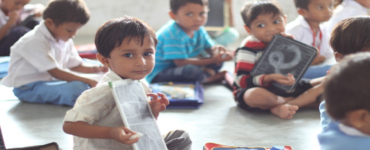Even if they are monolingual, mainstream K-12 teachers need to take a multilingual stance toward their English language learners and engage in bi/multilingual practices. Their actions can be viewed along a continuum from no home language use to sustained multilingual practices.
Key words: teacher preparation, English language learners, multilingualism, multilingual stance
Despite the growing number of bi/multilingual students in U.S. schools, an “English-only” ideology still prevails in mainstream classrooms. Reinforced by English-only materials and assessments and an English-medium curriculum designed for fluent English speakers, it is not surprising that mainstream teachers purposefully or implicitly default to monolingual English practices in their classrooms (Catalano & Hamann, 2016; de Jong, 2013). However, the cognitive, cultural, economic, educational, and political benefits of bilingualism or multilingualism have historically been noted by various scholars in the field (Baker & Wright, 2017; de Jong, 2011).
Building on students’ cultural experiences and extending their home languages and literacies are indispensable scaffolds for learning and for success in school (e.g., de Jong, 2011; González, Moll, & Amanti, 2005). Although the use of students’ home languages has long been delegated as the sole responsibility of bilingual education teachers, effective English as a Second Language (ESL) teachers also strategically draw on students’ home languages for teaching and learning (Gersten & Baker, 2000; Lucas & Katz, 1994; Manyak, 2004). Some might argue that bilingual and ESL teachers engage in such bilingual practices not only because they understand their importance, but also because they can tap into their own bilingual repertoires when teaching English language learners (ELLs). It is often concluded that mainstream teachers, who often self-identify as monolingual English speakers, are unable to approach their teaching through a multilingual lens (Schwarzer, Haywood, & Lorenzen, 2003).
In this article we argue that if linguistically and culturally diverse students’ home languages play a key role in their learning English as an additional language and in affirming their identities as bilingual and bicultural individuals, then this principle would hold true regardless of the setting in which these students find themselves (de Jong, 2011, 2013). Even though mainstream classrooms may be English dominant classrooms, this should not imply that they are also monolingual classrooms (de Jong, 2013). In other words, drawing on students’ linguistic and cultural resources, or what we refer to here as taking a multilingual stance, should be integral to what all teachers do, regardless of whether they are mainstream, ESL, or bilingual teachers. In this article, we provide examples from studies that have examined bi/multilingual practices in mainstream elementary classrooms. We hope to show that bilingual skills are not a pre-condition for taking a multilingual stance, although teachers’ own bilingual repertoires certainly play a role in their ability to engage in certain types of bi/multilingual practices more easily. After reviewing examples, we propose that these practices can be conceptualized along a continuum that ranges from more passive (permissive) to active (affirmative) bi/multilingual practices.
Multilingual Practices in Mainstream Classrooms
A review of the limited articles that document bi/multilingual practices shows a wide range of strategies that mainstream teachers can use. For the purpose of this paper, we focus on strategies observed in elementary classroom settings in North America and discuss them in terms of (a) making home languages visible; and (b) structuring the classroom for home language use. Although “emergent bilinguals” (EBs) is increasingly used to describe students still learning English as an additional language when they come to school, we will use the term used in most formal policies, ELL.
Making ELLs’ Home Languages Visible
Teachers can bring home language resources into the classroom in ways that represent languages other than English in the environment and allow students to use resources in their home languages. For example, teachers can create a multilingual print environment that includes multilingual signs and posters (Freeman & Freeman, 1993; Herques, 2007; Schwarzer, et al., 2003; Schwarzer, 2007) and display the students’ names in different languages and alphabets (Pandey, 2014; Schwarzer, et al., 2003). They can include words both in English and the ELLs’ home languages in their word walls (Pappamihiel & Lynn, 2014).
Teachers can learn about their students’ home languages through student or parent interviews or by inviting community members to speak about their languages and cultures (Freeman & Freeman, 1993; Schwarzer, et al., 2003; Schwarzer, 2007). Herques (2007) introduces a language tree activity as a way to document students’ language use outside the classroom and relate their languages to the culture. This not only creates a platform for the ELLs to illustrate and inform diverse language backgrounds but also raises teachers’ awareness about their own linguistic and cultural backgrounds (Schwarzer & Acosta, 2014).
Teachers can also provide access to learning resources in students’ home languages through supplemental learning materials, books, and technology (Freeman & Freeman, 1993; Herques, 2007; Schwarzer, 2007). These materials can support ELLs’ access to the content, connect to their background knowledge, and link prior learning to new learning in English as an additional language.
Structuring the Classroom to Affirm Home Language Use
Teachers can take steps to structure their classroom discourse in ways that encourage students’ use of multiple languages. Grouping ELLs with other bilingual students who share their home language creates multiple affordances for learning (Pappamihiel & Lynn, 2014; Woodley & Brown, 2016). In these settings, ELLs can use their home languages to express meanings and discuss the task and content with peers to facilitate comprehension (Brooks & Karathanos, 2009; Kleyn & Yau, 2016) and group work completion (Cummins, 2006; Giambo & Szecsi, 2015).
Teachers can purposefully design and select activities that use their students’ home languages to enhance instruction. When mainstream teachers build some competence in their ELLs’ home languages and learn about those languages, this can have a positive impact on their attitudes towards language diversity (Herques, 2007; Hite & Evans, 2006; Schwarzer, 2007) and empathy for their students (Catalano & Hamann, 2016). With these richer language resources, teachers can use ELLs’ home languages to enhance comprehension, clarify concepts, and scaffold new vocabulary and literacy learning (Woodley & Brown, 2016).
Three additional teacher-driven strategies are highlighted in the literature. First, the use of cognates has been identified as an effective strategy to help ELLs with reading comprehension and vocabulary development in English (Brooks & Karathanos, 2009; Delbridge & Helman, 2016; Giambo & Szecsi, 2015; Kleyn & Yau, 2016; Pappamihiel & Lynn, 2014; Szilágyi, Giambo, & Szesci, 2013). Second, teachers can use bilingual books to support bilingualism and biliteracy (Cummins, 2007; Ernst-Slavit & Mulhern, 2003; Giambo & Szecsi, 2015; Gordon, 2018; Roessingh, 2011). Ernst-Slavit & Mulhern (2003, p. 6) show twelve ways that bilingual books can be integrated into the classroom. These are:
- introducing a new topic;
- supporting transfer of reading in first language (L1) to second language (L2);
- supporting independent reading;
- using L1 version as preview;
- using L1 as review;
- reading two versions for self-assessment;
- comparing and contrasting cognates;
- improving home-school connections;
- supporting family literacy programs;
- raising all children’s awareness of multiculturalism;
- helping teachers learn another language; and
- encouraging reading for pleasure.
A final, and related, strategy is collaboratively constructed, student-created bilingual books, or identity texts (Cummins, 2006; Giambo & Szecsi, 2015; Stille & Cummins, 2013). During the composing process, ELLs can be encouraged to use their home languages to plan and scaffold writing and to discuss the writing with peers. ELLs can compose their own bilingual texts using bilingual dictionaries and online translation tools (Cohen & Leoni, 2006; Cummins, 2006; Delbridge & Helman, 2016; Giambo & Szecsi, 2015; Woodley & Brown, 2016).
Towards a Continuum of Bi/Multilingual Practices
We propose that the activities identified in the literature can be viewed as part of a continuum of bi/multilingual practices. Schwarzer, et al. (2003) identify four different attitudes teachers may have to the use of the home language (forbid, allow, maintain, foster). We extend this framework and argue that teachers can engage in bi/multilingual practices that range from what we call “permissive” actions to “temporary compensatory” practices to taking an active “multilingual stance” that affirms multilingual practices as a norm (see Figure 1).
Permissive policies focus on allowing students to use their home languages in non-classroom settings (hallways, playground) and giving permission for students to use their home languages under specific conditions, if necessary. Next are what might be referred to as transitional practices where the students’ home languages are more strategically used by the teacher in an effort to make students feel welcomed and encourage access to content for ELLs at the beginning stages of English language development. Scaffolding content through the use of the home language moves further along the continuum but still reflects a temporary practice as it is enacted primarily for beginner ELLs. To move further toward the right side of the continuum, teachers take a multilingual stance toward the entire classroom at all times. They foster some level of multilingual competencies for all students, regardless of their home languages or their proficiency levels in English. They are in a continuous process of learning and using their students’ home languages and cultivating positive attitudes towards language diversity and the importance of bilingualism (Herques, 2007; Hite & Evans, 2006; Schwarzer, 2007). Collectively, these bi/multilingual practices make multilingualism the norm for all and allow for the development of multilingual skills, including metalinguistic and multilingual awareness. Figure 2 provides some examples of illustrative practices for each stage along the continuum.
Conclusion and Implications
As U.S. schools become more linguistically and culturally diverse, it is imperative that mainstream classrooms do not default to monolingual environments, even if the language of instruction is English. Mainstream teachers can draw on students’ home languages, even if their own knowledge of those languages is still developing. They can take a multilingual stance as they make decisions about how multilingualism is represented and used in their classrooms as a resource for all learners. The need for all teachers to take a multilingual stance and build the knowledge and skills to enact this stance in their classrooms challenges teacher preparation programs to go beyond developing teacher candidates’ knowledge of second language development and scaffolding English as an additional language instruction. In addition to this knowledge and skills, mainstream preservice teachers also need an understanding of bilingualism and to be provided with opportunities to engage with multilingual strategies.
References
Baker. C, & Wright, W. E. (2017). Foundations of bilingual education and bilingualism (6th ed.). Clevedon, UK: Multilingual Matters.
Brooks, K., & Karathanos, K. A. (2009). Building on the cultural and linguistic capital of English learner (EL) students. Multicultural Education, 16(4), 47-51.
Catalano, T., & Hamann, E. T. (2016). Multilingual pedagogies and pre-service teachers: Implementing “language as a resource” orientations in teacher education programs. Bilingual Research Journal, 39(3-4), 263-278. doi:10.1080/15235882.2016.1229701
Cohen, S., & Leoni, L. (2006). Dual language literacy practices in the mainstream and ESL classroom. Retrieved from http://www.multiliteracies.ca/index.php/folio/viewDocument/8/4495
Cummins, J. (2006). Identity texts: The imaginative construction of self through multiliteracies pedagogy. In O. García, T. Skutnabb-Kangas, & M. E. Torres-Guzmán (Eds.), Imagining multilingual schools: Language in education and globalization (pp. 51-68). Clevendon, UK: Multilingual Matters.
Cummins, J. (2007). Promoting literacy in multilingual contexts. What Works? Research Into Practice. Retrieved from http://www.edu.gov.on.ca/eng/literacynumeracy/inspire/research/Cummins.pdf
de Jong, E. J. (2011). Foundations for multilingualism in education: From principles to practice. Philadelphia, PA: Caslon Inc.
de Jong, E. J. (2013). Preparing mainstream teachers for multilingual classrooms, Association of Mexican American Educators Journal, 7(2), 40-49.
Delbridge, A., & Helman, L. A. (2016). Evidence-based strategies for fostering biliteracy in any classroom. Early Childhood Education Journal, 44(4), 307-316.
Ernst-Slavit, G., & Mulhern, M. (2003). Bilingual books: Promoting literacy and biliteracy in the second-language and mainstream classroom. Reading Online, 7(2), 1-14.
Freeman, D. E., & Freeman, Y. S. (1993). Strategies for promoting the primary languages of all students. The Reading Teacher, 46(7), 552-558.
Gersten, R., & Baker, S. (2000). What we know about effective instructional practices for English-language learners. Exceptional Children, 6(4), 454-470.
Giambo, D. A., & Szecsi, T. (2015). Promoting and maintaining bilingualism and biliteracy: Cognitive and biliteracy benefits & strategies for monolingual teachers. The Open Communication Journal, 9(1), 56-60.
González, N., Moll, L.C., & Amanti, C. (2005). Funds of knowledge: Theorizing practices in households, communities, and classrooms. Mahwah, NJ: Lawrence Erlbaum Associates.
Gordon, D. (2018). Using dual language story books to foster biliteracy. EAL Journal. Retrieved from https://ealjournal.org/2018/11/12/using-dual-language-story-books-to-foster-biliteracy/
Herques, A. J. (2007). Exploring a monolingual English-speaking teacher’s perceptions of classroom interventions to foster Hispanic English language learners’ primary language (Unpublished doctoral dissertation). Retrieved from https://scholarworks.uno.edu/cgi/viewcontent.cgi?referer=https://scholar.google.com/&httpsredir=1&article=1609&context=td
Hite, C. E., & Evans, L. S. (2006). Mainstream first-grade teachers’ understanding of strategies for accommodating the needs of English language learners. Teacher Education Quarterly, 33(2), 89-110.
Kleyn, T., & Yau, H. (2016). The grupito flexes their listening and learning muscles. In O. García & T. Kleyn (Eds.), Translanguaging with multilingual students: Learning from classroom moments (pp. 100-117). New York: Routledge.
Lucas, T., & Katz, A. (1994). Reframing the debate: The roles of native languages in English-only programs for language minority students. TESOL Quarterly, 28(3), 537-561. https://doi.org/10.2307/3587307
Manyak, P. (2004). “What did she say”: Translation in a primary-grade English immersion class. Multicultural Perspectives 6(11), 12-18.
Pandey, A. (2014). Using mother tongues as building blocks in childhood education. Childhood Education, 90(1), 61-67. doi:10.1080/00094056.2014.872517
Pappamihiel, E., & Lynn, C. A. (2014). How can monolingual teachers take advantage of learners’ native language in class? Childhood Education, 90(4), 291-297. doi:10.1080/00094056.2014.937258
Roessingh, H. (2011). Family treasures: A dual-language book project for negotiating language, literacy, culture, and identity. Canadian Modern Language Review, 67(1), 123-148. https://doi.org/10.3138/cmlr.67.1.123
Schwarzer, D. (2007). Monolingual teachers fostering students’ native literacies. In Y. Goodman & P. Martens (Eds.), Critical issues in early literacy (pp. 111-122). Retrieved from https://www.researchgate.net/profile/David_Schwarzer2/publication/281973157_Monolingual_Teachers_Fostering_Students’_Native_Literacies/links/5600465e08aeafc8ac8c597d.pdf
Schwarzer, D., & Acosta, C. (2014). Two activities for multilingual students: Learning in monolingual classrooms. Journal of Multilingual Education Research, 5(1), 93-110.
Schwarzer, D., Haywood, A., & Lorenzen, C. (2003). Fostering multiliteracy in a linguistically diverse classroom. Language Arts, 80(6), 453-460.
Stille, S., & Cummins, J. (2013). Foundation for learning: Engaging plurilingual students’ linguistic repertoires in the elementary classroom. TESOL Quarterly, 47(3), 630-638. https://doi.org/10.1002/tesq.116
Szilágyi, J., Giambo, D., & Szecsi, T. (2013). Teaching strategies: “What if I don’t speak it?” Classroom strategies to nurture students’ heritage languages. Childhood Education, 89(2), 117-121.
Woodley, H., & Brown, A. (2016). Balancing windows and mirrors: Translanguaging in a linguistically diverse classroom. In O. García & T. Kleyn (Eds.), Translanguaging with multilingual students: Learning from classroom moments (pp. 83-99). New York: Routledge.








